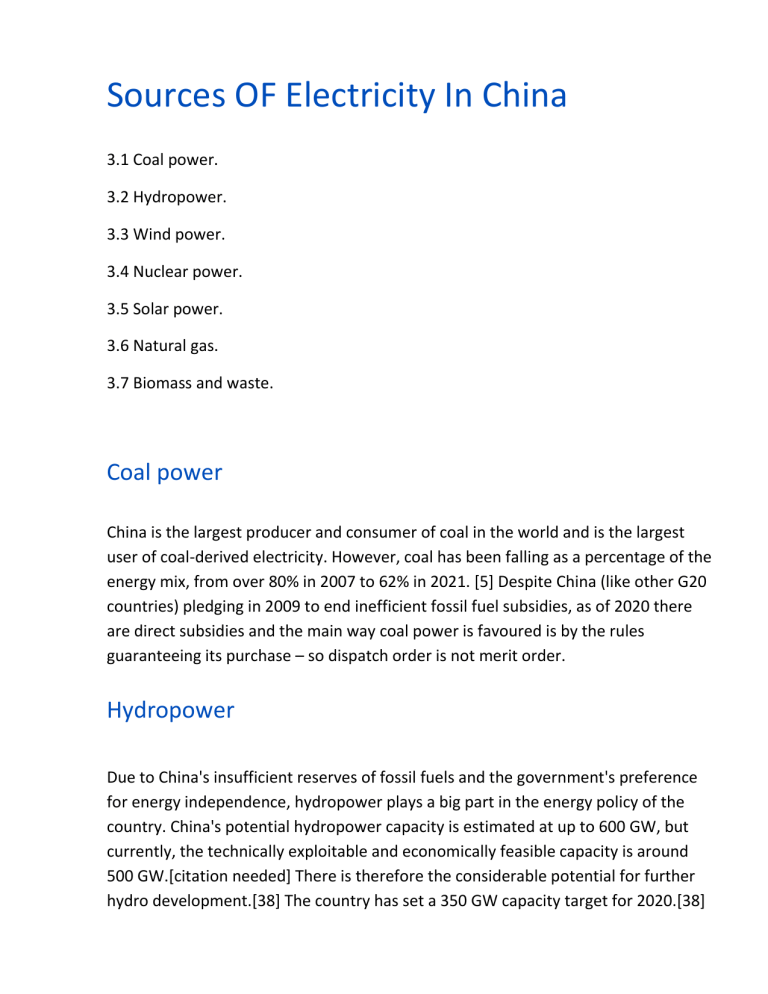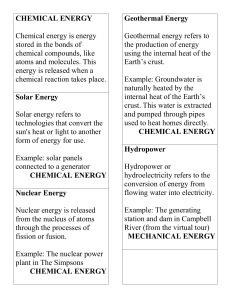
Sources OF Electricity In China 3.1 Coal power. 3.2 Hydropower. 3.3 Wind power. 3.4 Nuclear power. 3.5 Solar power. 3.6 Natural gas. 3.7 Biomass and waste. Coal power China is the largest producer and consumer of coal in the world and is the largest user of coal-derived electricity. However, coal has been falling as a percentage of the energy mix, from over 80% in 2007 to 62% in 2021. [5] Despite China (like other G20 countries) pledging in 2009 to end inefficient fossil fuel subsidies, as of 2020 there are direct subsidies and the main way coal power is favoured is by the rules guaranteeing its purchase – so dispatch order is not merit order. Hydropower Due to China's insufficient reserves of fossil fuels and the government's preference for energy independence, hydropower plays a big part in the energy policy of the country. China's potential hydropower capacity is estimated at up to 600 GW, but currently, the technically exploitable and economically feasible capacity is around 500 GW.[citation needed] There is therefore the considerable potential for further hydro development.[38] The country has set a 350 GW capacity target for 2020.[38] Being flexible, existing hydropower can back up large amounts of solar and wind.[28] Hydroelectric plants in China have relatively low productivity, with an average capacity factor of 31%, a possible consequence of rushed construction[38] and the seasonal variability of rainfall. Moreover, a significant amount of energy is lost due to the need for long transmission lines to connect the remote plants to where demand is most concentrated.[38] Although hydroelectricity represents the largest renewable and low greenhouse gas emissions energy source in the country, the social and environmental impact of dam construction in China has been large, with millions of people forced to relocate and large scale damage to the environment.[41] Wind power With its large land mass and long coastline, China has exceptional wind resources:[42] it is estimated China has about 2,380 GW of exploitable capacity on land and 200 GW on the sea.[43] At the end of 2021 there was 329 GW of Wind power in China proving 655,000 gigawatt-hours (GWh) of wind electricity to the grid[2] This contrast with the 114 GW of electricity generating capacity installed in China in 2014[44] (although capacity of wind power is not on par with capacity of nuclear power). [45] In 2011, China's plan was to have 100 GW of wind power capacity by the end of 2015, with an annual wind generation of 190 terawatt-hours (TWh).[46] Nuclear power In terms of nuclear power generation, China will advance from a moderate development strategy to an accelerating development strategy. Nuclear power will play an even more important role in China's future power development. Especially in the developed coastal areas with heavy power loads, nuclear power will become the backbone of the power structure there. As of February 2023, China has 55 plants with 57 GW of power in operation, 22 under construction with 24 GW and more than 70 planned with 88 GW. About 5% of electricity in the country is due to nuclear energy. [9] These plants generated 417 TWh of electricity in 2022. [48] This percentage is expected to double every 10 years for several decades out. Plans are for 200 GW installed by 2030 which will include a large shift to Fast Breeder reactor and 1500 GW by the end of this century. Solar power China has been the world's leading installer of solar photovoltaics since 2013 (see also growth of photovoltaics), and the world's largest producer of photovoltaic power since 2015.[51][52][53] In 2017 China was the first country to pass 100 GW of cumulative installed PV capacity.[54] However electricity prices are not properly varied by time of day, so do not properly incentivize system balancing.[55] Solar water heating is also extensively implemented, with a total installed capacity of 290 GWth at the end of 2014, representing about 70% of world's total installed solar thermal capacity.[56][57] The goal for 2050 is to reach 1,300GW of Solar Capacity. If this goal is to be reached it would be the biggest contributor to Chinese electricity demand.[58] T = Trillion K= Killo W= Walt H= Hour Holiday Homework Faaz Ahmed 7b






